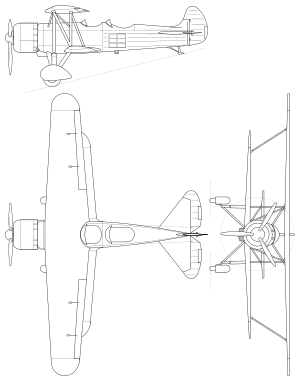Weiss WM-21 Sólyom
| WM-21 Sólyom | |
|---|---|
 | |
| Role | Light Bomber/Reconnaissance Biplane |
| National origin | Hungary |
| Manufacturer | Manfred Weiss |
| Introduction | 1939-1945 |
| Number built | 128 |
| Developed from | Weiss WM-16 Budapest |
The Weiss WM-21 Sólyom (English: Falcon) was a 1930s Hungarian light bomber and reconnaissance biplane developed by the Manfred Weiss company. It served in World War Two, often accompanied by other old, or else substandard, planes.
Design and development
The WM-21 was designed to replace the WM-16, which was based on the yet older Fokker C.V, and as such was considered unsuitable for operational service. The WM-21's structure was strengthened, and the aircraft received a new, more efficient wing set. A tailskid was fitted to allow for shorter landing runs on grass airfields.[1] A conventional biplane, the Sólyom was powered by a 870 hp (649 kW) Weiss WM-K-14A radial engine, and had an open cockpit.[1] A total of 128 aircraft were built by three different factories: 25 by Manfred Weiss, 43 by MAVAG, and 60 by MWG.[2]
Operational history
Throughout the war, the Royal Hungarian Air Force used 48 of them for reconnaissance. They served alongside 38 Heinkel He 46s, and 37 IMAM Ro.37s, supplemented by 13 Heinkel He 111s. They first entered service in 1939 with short-range reconnaissance units. Although they were active during the 1940 dispute with Romania, their first active operational use was during the Axis invasion of Yugoslavia in April of 1941.[1] During the invasion of Yugoslavia, none of the WM-21's were lost in combat, but one was lost in an accident.[3] From June 1941 they were used to support Hungarian Army units in Ukraine, and then against Soviet partisans.[1] They lost another WM-21 on June 29, when the war against the Soviet Union was intensifying.[4] Around 80 aircraft were also transferred to duties as trainers, as they were removed from operational use, until 1945.[1]
Operators
Specifications

General characteristics
- Crew: 2
- Length: 9.64 m (31 ft 8 in)
- Upper wingspan: 12.90 m (42 ft 4 in)
- Lower wingspan: 9.40 m (30 ft 10 in)
- Height: 3.5 m (11 ft 6 in)
- Empty weight: 2,300 kg (5,071 lb)
- Gross weight: 3,400 kg (7,496 lb)
- Powerplant: 1 × Weiss WM-K-14A radial, 650 kW (870 hp)
Performance
- Maximum speed: 320 km/h (199 mph; 173 kn)
- Range: 750 km (466 mi; 405 nmi)
Armament
- Guns: 3 x 7.9mm (0.31in) Gebauer machine-guns
- Bombs: 12 x 10kg (22lb) Anti-personnel bombs or 60 x 1kg (2.2 lb) incendiary bombs
References
Notes
- 1 2 3 4 5 6 Orbis 1985, p. 3079
- ↑ Gunston, Bill (1993). World encyclopaedia of aircraft manufacturers : from the pioneers to the present day. Annapolis: Naval Institute Press. p. 324. ISBN 9781557509390.
- ↑ Renner, Stephen L. (2016). Broken Wings: The Hungarian Air Force, 1918-45. Indiana: Indiana University Press. p. 246. ISBN 9780253023391.
- ↑ Renner, Stephen L. (2016). Broken Wings: The Hungarian Air Force, 1918-45. Indiana: Indiana University Press. p. 260. ISBN 9780253023391.
- ↑ "AWM-21 Sólyom". Retrieved 28 January 2012.
Bibliography
- The Illustrated Encyclopedia of Aircraft (Part Work 1982-1985). Orbis Publishing.